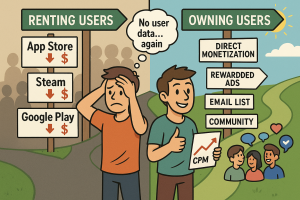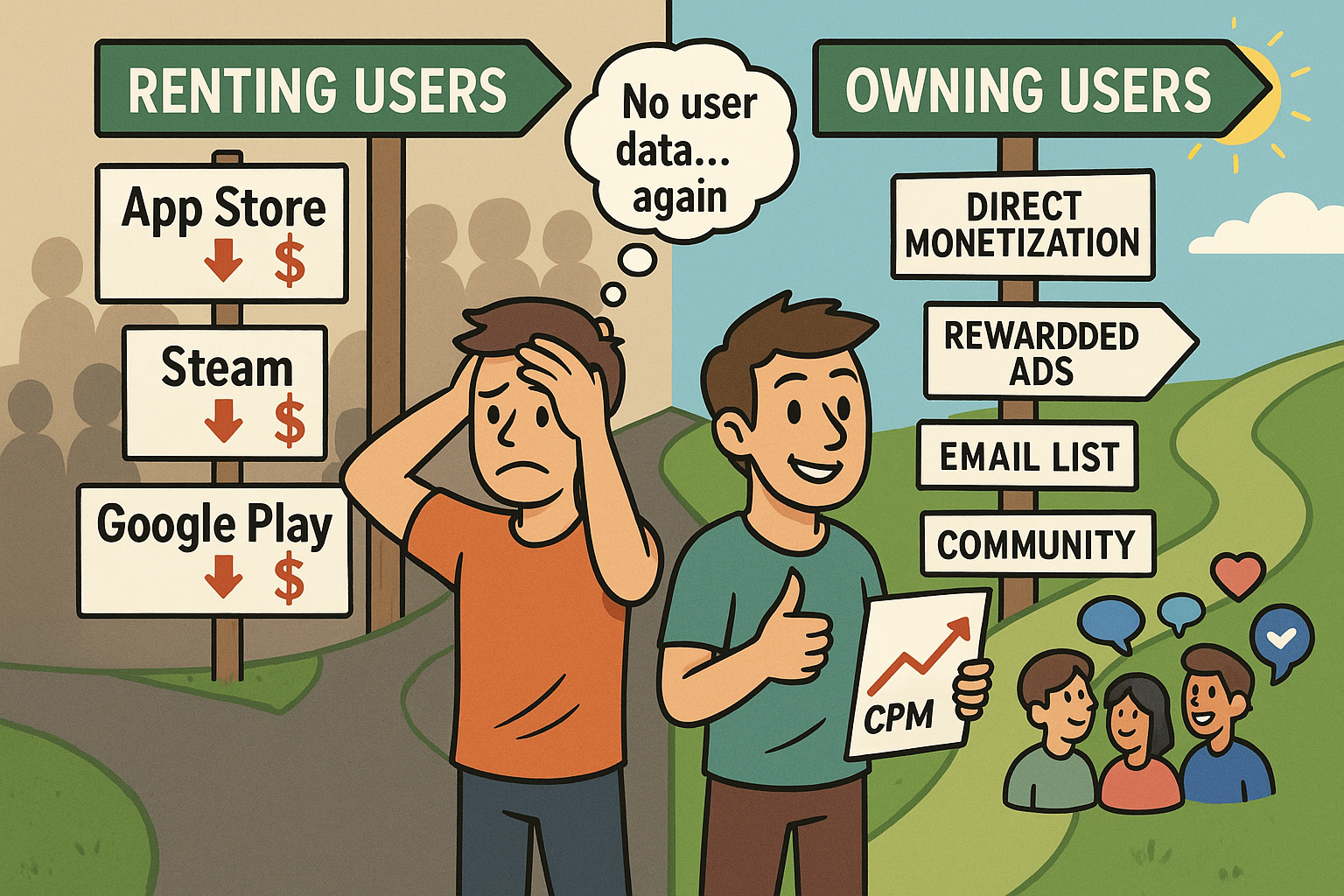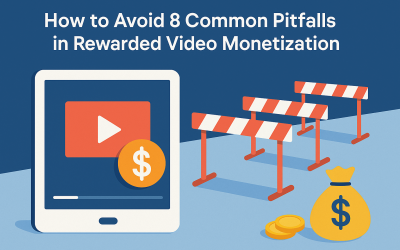Rethinking Game Distribution: Renting Vs Owning Your Game Players
The digital gaming industry has reached a critical inflection point. Developers worldwide are recognizing that traditional platform-dependent distribution models, while offering immediate market access, fundamentally compromise long-term business sustainability and growth potential.
Consider the mathematics: A developer distributing exclusively through major platforms forfeits 30% of gross revenue while simultaneously surrendering user data, brand control, and monetization autonomy. This model transforms what should be business assets—player relationships and revenue streams—into borrowed resources subject to external policy changes and algorithmic volatility.
The solution lies in transitioning from a rental model to an ownership model: building direct relationships with users while maintaining complete control over monetization infrastructure. This strategic shift enables developers to maximize revenue potential, gather actionable user insights, and create sustainable competitive advantages independent of platform dependency.
Contents
- 1 Current Platform Distribution: A Rental Economy Analysis
- 2 The Strategic Cost of Platform Dependence
- 3 Ownership Model: Direct User Relationship Management
- 4 Monetization Optimization Through Ownership
- 5 Implementation Framework: Essential Tools and Platforms
- 6 Strategic Implementation: Hybrid Distribution Approach
- 7 AppLixir: Building Sustainable Gaming Businesses
Current Platform Distribution: A Rental Economy Analysis
The prevailing game distribution ecosystem operates on what economists would recognize as a rental model. Platforms including Steam, Apple App Store, Google Play Store, and console marketplaces provide developers with access to established user bases in exchange for significant revenue sharing and operational constraints.
Platform Value Proposition
Major distribution platforms offer substantial infrastructure benefits:
- Market Access: Steam’s 120+ million monthly active users and mobile app stores’ billions of device reach provide unparalleled audience exposure for individual developers.
- Technical Infrastructure: Platforms manage complex backend operations including payment processing, content delivery networks, user authentication systems, and customer support frameworks.
- Discovery Mechanisms: Algorithmic recommendation systems, editorial features, and category-based browsing facilitate user acquisition without requiring sophisticated marketing expertise.
- These benefits explain why platform distribution remains the default strategy for many developers, particularly those launching their first commercial products.
Hidden Operational Costs
However, platform dependence introduces substantial long-term costs that extend beyond immediate revenue sharing:
- Revenue Dilution: Standard 30% platform fees significantly impact unit economics, particularly for price-sensitive markets or lower-margin products.
- Data Asymmetry: Platforms retain comprehensive user analytics while providing developers with limited demographic insights and behavioral data, constraining data-driven optimization opportunities.
- Policy Vulnerability: Monetization strategies, content guidelines, and revenue sharing terms remain subject to unilateral platform modifications, creating systemic business risk.
- Algorithmic Dependency: Game visibility relies entirely on opaque recommendation algorithms that can change without notice, making sustainable marketing planning nearly impossible.
The Strategic Cost of Platform Dependence
Platform dependency creates fundamental business vulnerabilities that compound over time:
Brand Dilution and Customer Loyalty Fragmentation
When users discover games through platform recommendation engines, loyalty typically aligns with the platform rather than the developer brand. This dynamic weakens direct customer relationships and reduces cross-product marketing effectiveness.
Communication Channel Limitations
Platform-mediated user relationships prevent developers from building direct communication channels essential for community development, feedback collection, and new product marketing. Every user interaction occurs within platform-controlled environments subject to external policies and restrictions.
Algorithmic Revenue Volatility
Platform algorithms determine game visibility based on factors including user engagement metrics, competitive analysis, and platform strategic priorities. These systems create unpredictable revenue fluctuations independent of actual product quality or market demand.
Monetization Strategy Constraints
Platform policies restrict monetization approaches, advertising implementations, and pricing strategies. Mobile platforms, in particular, have implemented increasingly restrictive policies around user data collection and targeted advertising, directly impacting revenue optimization potential.
Ownership Model: Direct User Relationship Management
Transitioning to an ownership model requires building direct relationships with users while maintaining complete control over monetization infrastructure and user data.
Direct Distribution Strategies
- Web-Based Game Deployment: HTML5 and WebGL technologies enable developers to deliver high-quality gaming experiences directly through web browsers, eliminating download friction and platform approval processes.
- Proprietary Website Development: Creating dedicated game portals establishes brand-controlled environments where developers can implement unlimited monetization strategies and gather comprehensive user analytics.
- Alternative Distribution Channels: Platforms like itch.io offer developer-favorable revenue sharing and increased creative control, while emerging blockchain-based distribution models provide novel monetization opportunities.
User Data and Analytics Ownership
Direct distribution enables comprehensive user behavior analysis, including session duration, feature utilization, monetization conversion rates, and retention metrics. This data becomes invaluable for product optimization and marketing strategy refinement.
Brand Control and Community Development
Owning user relationships enables developers to build authentic brand communities through direct communication channels, social media engagement, and exclusive content distribution.
Monetization Optimization Through Ownership
Direct user ownership unlocks sophisticated monetization strategies impossible within platform-constrained environments.
Advanced Revenue Stream Diversification
- Rewarded Video Advertising: Implementing rewarded video ads through specialized platforms like AppLixir enables developers to generate significant revenue while maintaining positive user experiences. AppLixir’s focus on web-based games specifically addresses the unique requirements of browser-based gaming monetization, offering competitive CPMs and seamless integration capabilities.
- Flexible Pricing Models: Direct monetization enables dynamic pricing strategies, subscription services, seasonal passes, and geographic pricing optimization without platform restrictions.
- Cross-Product Revenue Synergies: Owning user relationships enables monetization across entire game portfolios rather than individual titles, significantly increasing customer lifetime value.
Enhanced Revenue Economics
Eliminating platform revenue sharing immediately increases profit margins by 20-30%. Combined with optimized payment processing (typically 2-3% fees through services like Stripe), developers can achieve substantially improved unit economics.
AppLixir exemplifies this advantage by enabling developers to implement rewarded video advertising with industry-leading CPMs specifically optimized for web-based gaming experiences. Their platform integrates seamlessly with existing game infrastructure while providing comprehensive analytics and optimization tools.
Data-Driven Optimization
Direct access to user analytics enables sophisticated A/B testing of monetization strategies, user interface optimizations, and content delivery methods. This data-driven approach creates competitive advantages that compound over time.
Implementation Framework: Essential Tools and Platforms
Successful transition to user ownership requires strategic tool selection across multiple operational areas:
Monetization Infrastructure
- AppLixir: Specialized rewarded video advertising platform designed specifically for web-based games, offering superior CPMs and developer-friendly integration tools.
- Payment Processing: Stripe and PayPal provide robust, low-cost payment solutions with extensive customization options and comprehensive fraud protection.
- Analytics Platforms: Google Analytics 4 offers sophisticated user behavior tracking, while specialized gaming analytics tools provide deeper engagement insights.
Community and Marketing Tools
- Email Marketing: ConvertKit and Mailchimp enable sophisticated user segmentation and automated marketing campaigns essential for long-term user relationship management.
- Community Platforms: Discord servers and proprietary forums create spaces for direct user engagement and feedback collection.
Development and Testing Infrastructure
- A/B Testing: Optimizely and Google Optimize enable systematic monetization strategy optimization through controlled experimentation.
- User Experience Analysis: Hotjar provides heatmapping and session recording capabilities essential for optimizing conversion rates and user engagement.
Strategic Implementation: Hybrid Distribution Approach
The optimal strategy combines platform distribution for user acquisition with owned channels for relationship development and monetization optimization.
Acquisition Through Platforms, Monetization Through Ownership
- Discovery Phase: Utilize platforms for initial user acquisition and market validation while implementing strategies to drive users toward owned channels.
- Relationship Development: Direct acquired users to proprietary websites, email lists, and community platforms where deeper engagement and superior monetization become possible.
- Revenue Optimization: Implement advanced monetization strategies through owned channels while using platform versions primarily for user acquisition rather than revenue generation.
AppLixir Integration Strategy
For developers implementing this hybrid approach, AppLixir provides essential monetization infrastructure for owned channels. Their rewarded video advertising platform generates superior revenue compared to platform-mediated advertising while maintaining complete developer control over implementation and optimization.
This approach enables developers to use platforms for their primary strength—user acquisition—while leveraging owned channels and specialized monetization partners like AppLixir for revenue optimization.
AppLixir: Building Sustainable Gaming Businesses
The gaming industry’s future belongs to developers who build sustainable businesses through user ownership rather than platform dependency. This transition requires strategic investment in direct user relationship development, advanced monetization infrastructure, and data-driven optimization capabilities.
Companies like AppLixir represent the evolution of monetization technology specifically designed to support developer independence. Their platform enables sophisticated revenue generation while maintaining the user experience quality essential for long-term engagement.
The transition from renting to owning users represents more than a tactical shift—it’s a fundamental business model evolution that creates sustainable competitive advantages and long-term revenue growth potential.
Developers ready to build truly independent gaming businesses should begin implementing owned channel strategies immediately, starting with simple web-based game deployment and advanced monetization through specialized platforms like AppLixir.
The future of gaming lies not in platform dependency, but in developer empowerment through user ownership and monetization control.



